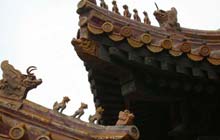
 Beijing or Northern Capital was made capital of the world's largest ever, land-based empire by the Mongol conqueror, Kublai Khan, in 1271. What was then the quiet market town of Yanjing was promptly remodelled into a glorious city befitting the attention and tributes of the world.
Beijing or Northern Capital was made capital of the world's largest ever, land-based empire by the Mongol conqueror, Kublai Khan, in 1271. What was then the quiet market town of Yanjing was promptly remodelled into a glorious city befitting the attention and tributes of the world.
After the Mongols were overthrown in the coup of 1368, however, the first Ming Emperor Hongwu (r. 1368-1398) relocated the capital elsewhere. His descendant, unnerved by the continuing threat of the Mongols to the North, returned here half a century later. Yong Le (r. 1402-1424), the third Ming emperor, cleared away the Mongols' palaces and redesigned the capital city to reflect the greater glory of the new, ethnically Han Chinese dynasty. It was during this reign that the Forbidden City took its current form. In effect Beijing, as it was now named, was divided by perimeter walls into two cities – a rectangular Forbidden City to the North adjoining an oblong Imperial one to the South.
When the Manchus invaded China to establish the Qing dynasty (1644-1910), they kept much of Beijing's architecture unchanged. Indeed, the Manchus were so thoroughly sinicized that they came to embody the Ming dynasty's most conservative values. Their most notable additions to Beijing's architecture are the Imperial summer palaces to the city's north.
Beijing Today
Some of the architecture that you see today dates to the first decades of communist rule. In many cases Soviet designs, such as you'll find all over Eastern Europe, were used to provide inexpensive structures for the incipient and penniless state. Since the mid-80s though, Beijing has seen a differently motivated construction boom. Taiwanese, Singaporean and Hong Kong business people are investing more and more money into the city's burgeoning skyline. Like Jack and his Beanstalk, Beijingers wake up every morning to see that their city has grown even taller, as if by magic.
It may surprise you to see that so many Western shops, brands and products have preceded you here. For the most part, Chinese people do not look like they can afford a Rolex, a Ferarri or a Burberry. Yet somebody's buying them! Since it's not in the interest of affluent mainland Chinese to draw attention to themselves, it's up to you to go out and seek the new China.